
Microbial Food Webs
Importance
Life in the ocean is microbe based. Most of the biomass and biological activity in the ocean is microscopic, and microbes dominate earth's carbon, oxygen, sulphur, and nitrogen cycles. There are 100 million times more bacteria in the ocean than stars in the known universe, and there are a thousand times more viruses than bacteria. Yet we know little about the relationships between microbes and their environment because only one tenth of one percent of the bacteria have ever been cultured. The traditional marine food web exists in a sea of microbes and dissolved carbon-based matter.
The pelagic food web is microbe-centric...The ‘diatom-copepod-fish’ food web is a relatively minor component.
Barber & Hilting (2000).
The entire microbial food web, including protozoan microzooplankton, is typically some five to ten times the mass of all multicellular marine organisms. The potential metabolic dominance of microorganisms is even greater than their biomass suggests ... Put in more understandable terms, a mass of B. natrigens [a bacteria] equal to 100 humans would have an energy throughput of about a gigawatt, much the same as a nuclear power station. This metabolic potential under optimal circumstances would be rarely, if ever, achieved in nature for a number of reasons, notably the low concentrations of organic nutrients ...
Pomeroy et al (2007).The microbial food web...has been a major theme of biological oceanography over the past two decades…
Ducklow (2000).
One approach to understanding the relationships between micro-organisms and their ocean environment is to examine their RNA and DNA using, for example, the shotgun technique whereby DNA is removed from cell samples and forced through a tiny nozzle to break the DNA into millions of fragments. In 2003, Craig Venter and colleagues used the technique to analyze the DNA sequences of micro-organisms in water collected from the Sargasso Sea near Bermuda and found
1800 genomic species based on sequence relatedness, including 148 previously unknown bacterial phylotypes. We have identified over 1.2 million previously unknown genes represented in these samples, including more than 782 new rhodopsin-like photoreceptors. – Venter et al (2004).
Read more about Venter's ocean work in the Wired Magazine article Craig Venter's Epic Voyage to Redefine the Origin of the Species and Carleton University's web pages on marine microbes.
Another approach has been to measure the number of microbes, their productivity, and the amount of particulate matter in the water to calculate how much the microbes contribute to various parts of the oceanic food web. This approach shows that microbes, especially the picoplankton, microbial plankton with sizes ranging from 0.2 to 2.0 microns, are as important as the traditional marine food web.
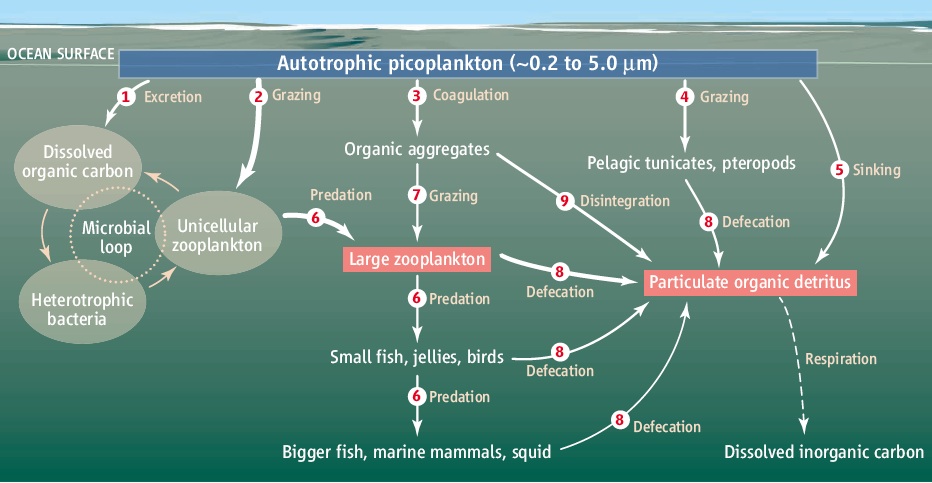
The microbial food web (loop on the left) is an important part of the marine food web. Picoplankton feed larger zooplankton directly (path 6) and indirectly (paths 3, 4, and 6), and they contribute to particulate and dissolved carbon in the ocean. Click on image for a zoom.
From Barber (2007).
The Microbial Food Web Is Mostly Unknown
The staggering variety of microbes discovered through shotgun DNA analysis shows how little we know about the microbial web. Craig Venter, in a second voyage of discovery from New England to the southwest Pacific, returned with billions of bases of DNA sequences.
Venter’s team has found evidence of so many new microbial species that the researchers want to redraw the tree of microbial life... [They] identified more than 400 microbial species new to science... The vast majority of the microbes that found themselves snared in Venter’s filters were genetically unique... Based on their best guess as to the beginning and end of each gene teased out from the DNA sequences, Venter Institute computational biologist Shibu Yooseph and his colleagues have concluded that the DNA encodes 6.12 million hypothetical proteins. That finding almost doubles the number of known proteins in a single stroke... Most of the predicted proteins are of unknown function, and a quarter of them have no similarity to any known proteins... By comparing predicted amino acid sequences with those of known proteins, they found a surprising abundance of signaling proteins thought to be used only by multicellular organisms. Among the hypothetical proteins from their marine samples, the researchers found 28,000 of the so-called eukaryotic protein kinases, as well as another 19,000 of a group that are highly similar to these kinases— triple the number previously known...
From Ocean Study Yields a Tidal Wave of Microbial DNA by Bohannon (2007).
Read that quote again. One 10-month expedition that sampled the ocean at just 41 locations returned with hundreds of new species able to make millions of proteins that were previously unknown, including tens of thousands that were thought to occur only in higher, multi-celled organisms. And this is from only a tiny part of the ocean. Clearly, the microbial web is almost unknown. A vast new frontier of life awaits discovery.
With this in mind, here is a brief outline of what we have learned so far.
Organisms Comprising the Microbial Food Web
The microbial web includes bacteria and archaea (prokaryotes without a cell nucleus) and very small eukaryotes (organisms having cells with a nucleus), ranging in size from 0.01 micrometers for viruses to 20 micrometers for ciliates, living in a dilute broth of carbon-based matter ranging from individual molecules to tangled polymers to colloids to clumps of dead matter called marine snow.
Here is an impressionistic view of microbial life in the sunlit waters of the ocean.
The microbial loop: impressionist version. A bacteria-eye view of the ocean's sunlit layer. Seawater is an carbon-based matter continuum, [a scientific way to say "soup"], a gel of tangled polymers with embedded strings, sheets, and bundles of fibrils and particles, including living organisms, as "hotspots." Bacteria (red) acting on marine snow (black) or algae (green) can control sedimentation and primary productivity; diverse micro-niches (hotspots) can support high bacterial diversity.
From Azam (1998).
- Viruses, including bacteriophages Most
of the biomass in the ocean is made up of viruses–Zimmer
(2006). They attack and kill bacteria, archaea and other micro-organisms,
which releases the dead's cell contents, adding to the carbon-based
material in the water, and they are able to manipulate the evolution
of other microbial life in the ocean in remarkable ways. There
are more than 5,000 different types of viruses in 100 ml of seawater,
and more than 1,000,000 in a kilogram
of sediment (Rowher 2009).
Patrick Forterre, an evolutionary biologist at the University of Paris-Sud in Orsay, France, believes that viruses are at the very heart of evolution. Viruses, Forterre argues, bequeathed DNA to all living things. Trace the ancestry of your genes back far enough, in other words, and you bump into a virus. – Zimmer (2006).
Viruses can be considered to be on the threshold between living and non-living. In a sense, they can cause themselves to be reproduced, so they could be considered as being "alive". But they can only do this by using the machinery of a host cell. Without a host they exist only as inert, almost crystal-like, "non living" particles in the environment. They range generally from 17 to 1000 nm in size (a nanometer = 10-9m). Viruses are generally host specific, that is a given virus will generally affect only a certain species or group of related species, or even only certain kinds of cells within a species.
From Background information on Viruses, Bacteria and Prions at Marine Science Online Magazine (no longer in production).
...ocean waters contain about ∼ 4 × 1030 viruses. Because a marine virus contains about 0.2 fg [1 fg = 1 femto-gram = 10-15 gram] of carbon and is about 100 nm long, this translates into 200 Megatons of carbon in marine viruses. If the viruses were stretched end to end they would span ∼ 10 million light years. In context, this is equivalent to the carbon in ∼ 75 million blue whales (∼ 10% carbon, by weight), and is ∼ 100 times the distance across our own galaxy. – Suttle, C. A. (2005).
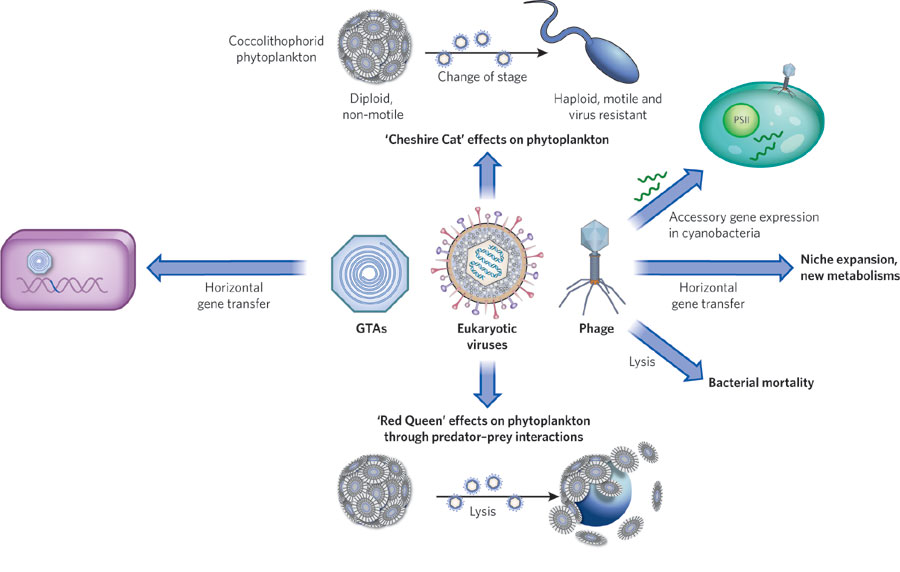
Marine viruses and viral-like entities, including eukaryotic viruses, phage and generalized transducing agents (GTAs), can have various effects on host cells. When a phage infects its bacterial host cell, it can either kill the cell (lysis), or transfer genetic material obtained from a previous host (horizontal gene transfer) or from its own genome (accessory genes expression). The transferred genes can allow a cell to expand into different niches (for example, through the activation of photosynthetic genes, changing the life cycle of important phytoplankton such as cyanobacteria and coccolithophorids). Similarly, small viral-like particles known as GTAs can transfer genes between marine organisms. Two possible scenarios have been proposed for viral effects on cells. In the 'Red Queen' effect, the virus and cell are locked in an evolutionary 'arms race', such that they continue to evolve mechanisms of resistance to each other until eventually the virus causes the host cell (illustrated here by a coccolithophorid) to die. In the 'Cheshire Cat' hypothesis, however, the coccolithophorid simply moves from its diploid, non-mobile stage to a motile, haploid stage, thereby evading the virus.
From Rohwer 2009.
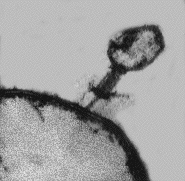
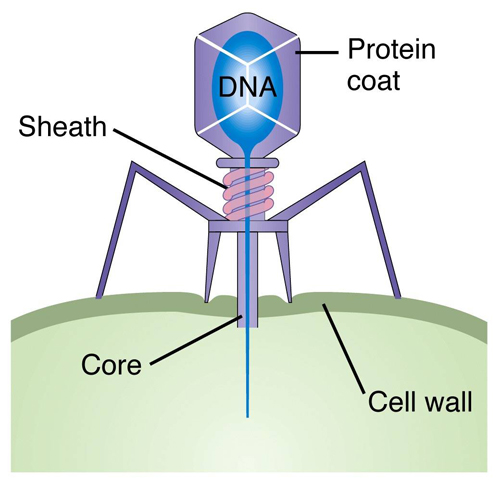
Left: A T4 bacteriophage infecting a bacterium. From An Introduction to the Bacteriophage T4 Virus at dFORM.
Right: A cartoon of a typical bacteriophage. From Molecular nanomachines at the Department of Biochemistry, University of Zurich.
To learn more about how a phage can inject DNA into a cell read The Physics of Phages (Gelbart and Knobler, 2008)
- Bacteria The ocean is filled with
a countless mob of bacteria with a staggering variety of genes according
to Bohannon (2007). The bacteria are a critical part of the marine
food web, processing more than half of all the flow of carbon-based
matter. Some use sunlight for energy to synthesize hydrocarbons, the
photosynthetic bacteria, some use both sunlight and carbon-based material
for energy, the mixotrophs, and some attack other organisms, the heterotroph
(see the vocabulary section below). The photosynthetic bacteria produced
the oxygen and reduced carbon (carbohydrates) starting billions
of years ago. As carbon was buried in sediments, oxygen accumulated
in the atmosphere (see Role of Ocean
in Climate).
The total mass of bacteria in the ocean exceeds the combined mass of zooplankton and fishes.– Pomeroy et al (2007).
It [was] generally thought that pelagic bacteria passively receive dissolved carbon-based matter leaking from the grazing food chain and diffused homogeneously. However, recent studies on the complex nature of the carbon-based matter field and behavioral strategies of bacteria have suggested that bacteria do not use only preformed dissolved carbon-based matter; they also attack all carbon-based matter, even live organisms, thus liberating dissolved carbon-based matter. Hence, bacterial attack can profoundly modify the biogeochemical behavior of carbon-based matter in ways not inferred from measuring cumulative carbon-based matter fluxes into bacteria.
From Azam (1998).
- Cyanobacteria are the most common type of bacteria in the ocean,
and SAR11 (Pelagibacter clade
[group of closely related organisms] of
the Synechoccus types of bacteria) is the most common organism on
earth, accounting for roughly 25% of all the bacteria in the ocean. Prochlorococcus and Synechoccus species
dominate the microbial ecology of the ocean. They account for 25%
of global photosynthesis. Yet, they were mostly unknown until Sallie
W. Chisholm, a professor at the Massachusetts Institute of Technology,
first discovered
Prochloroccus in 1988.
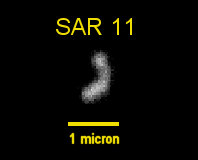
The marine bacterium SAR11, the most common organism on earth. It was discovered by Stephen Giovannoni of Oregon State University in 2002.
From Stephen Giovannoni, Oregon State University, Department of Microbiology.
-
Vibrio bacteria Although bacteria
are very common in the ocean, very few cause disease in people. But
some are deadly.
- The marine bacteria found in most coastal waters, Vibrio cholerae, causes cholera.
- Vibrio
vulnificus, which is also found in
coastal waters, including Texas lagoons, causes a flesh-eating
disease (necrotizing
fasciitis) that can kill in a few days without prompt treatment.
If you have a cut that becomes infected after
you were in warm lagoon water, go directly to an emergency
room, especially if the infection spreads. Some
infections can increase from the size of a nickel to the size
of a quarter in a few hours. The
bacteria causes roughly 500 infections and 40 deaths each year
in the USA.
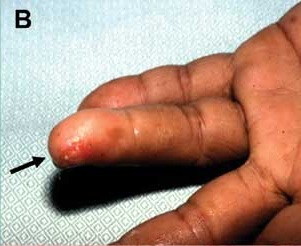
V. vulnificus bacterial infection that developed one day after a fish bone injury on the fourth finger of the left hand (arrow) in a 45-year-old patient with uremia.
From Bacteriology at UW- Madison. More information on Vibrio vulnificus.
- Cyanobacteria are the most common type of bacteria in the ocean,
and SAR11 (Pelagibacter clade
[group of closely related organisms] of
the Synechoccus types of bacteria) is the most common organism on
earth, accounting for roughly 25% of all the bacteria in the ocean. Prochlorococcus and Synechoccus species
dominate the microbial ecology of the ocean. They account for 25%
of global photosynthesis. Yet, they were mostly unknown until Sallie
W. Chisholm, a professor at the Massachusetts Institute of Technology,
first discovered
Prochloroccus in 1988.
- Archaea They look very much like bacteria,
but they are no more closely related to bacteria than we are to bacteria.
The Archaea dominate some oceanic areas, especially below the sunlit
zones, where "they
make up typically 40% of deep-sea organisms–and
the deep sea is by far the largest habitat on earth" –
Jed Fuhrman, University of Southern California, quoted in Copley (2002).
Overall,
"20% of all the picoplankton cells in
the world ocean appear to be represented by one specific clade, the
pelagic [open-ocean] crenarchaeota". – Karner,
2001.
Archaea are important for earth's nitrogen and methane cycles. They are important chemotrophes. As far as is known, however, archaea do not photosynthesize and produce oxygen. But they can use sunlight as a source of energy.
They also dominate sub-sea sediments:
The deep biosphere is large, and, at least in aggregate, it is 'alive'. The data almost defy imagination — on the order of a million cells in every cubic centimeter of sediment buried half a kilometer below the sea floor, or more than 50% of all microbial cells on Earth. The overall order of magnitude is the same as the biomass of all surface plant life. In investigating what kind of cells they are, Lippy et al. (2008) conclude that, deeper than 1 meter below the sea floor, it is Archaea, not Bacteria, that contribute the bulk of sedimentary microbial biomass. If true, Archaea would be the most abundant cell type in the marine system, rivalling Bacteria in total numbers globally.
From Pearson (2008).
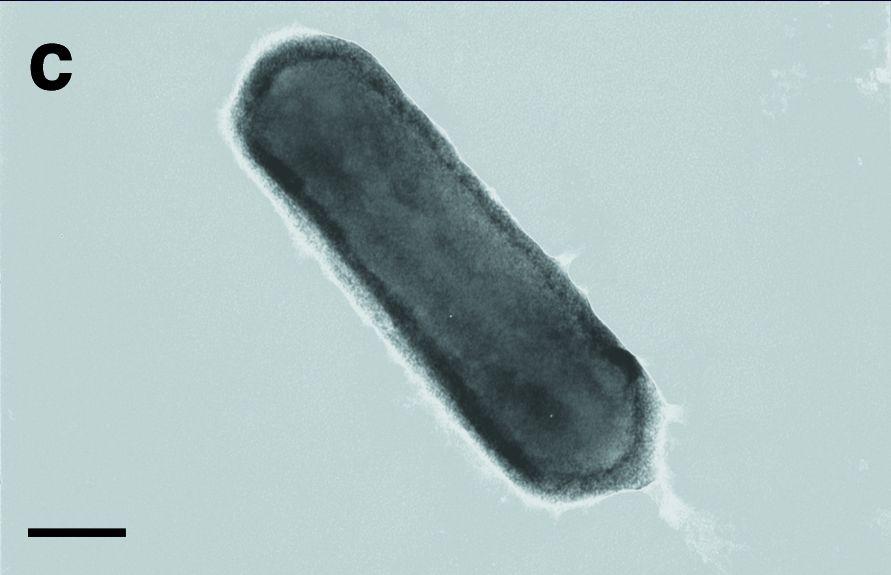
Transmission electron micrograph of Nitrosopumilus maritimus, (also known as SCM-1), an archae of the kingdom crenarchaeota. Very similar, open-ocean crenarchaeota are thought to have an important influence on the nitrogen cycle. Scale bar represents 0.1 micrometer.
From Nature Article: Isolation of an autotrophic ammonia-oxidizing marine archaeon by Könneke et al (2005).
- Chromalveolata This very large group
of single-celled eukaryotes (organisms with a cell nucleus), includes
dinoflagellates, coccolithophores, and diatoms which are important
organisms at the base of the marine-fisheries
food webs, and other organisms, such as
ciliates, described below.
- Dinoflagellates are a large group
of organisms with two, hair-like flagella which they use to swim
through the water. About half of the species are photosynthetic.
Some species occur in dense blooms of more than 109 cells
per liter called harmful
algal blooms, producing potent neurotoxins that accumulate
in marine animals and that kill fish. People become ill or die
when they eat fish or shell fish that have accumulated the toxins.
Some species are the zooxanthellae that live in the cells of corals
and anemones. Others, such as Noctiluca,
produce light when disturbed. Dinoflagellates tend to dominate
in regions of low turbulence and nutrients, such as oceanic areas
in late summer. Sizes range from 30 micrometers for some marine
species up to 2,000 micrometers (2 mm) for Noctiluca.
Leucocryptos marina, a marine dinoflagellate species.
From: Leucocryptos marina (Braarud) Butcher 1967, Marine Botany group in the Department of Marine Ecology, Göteborg University, Sweden.
- Coccolithophores are small organisms
with two smooth flagella and covered by calcareous plates called
coccoliths.They dominate in regions of moderate turbulence and
nutrients such as mid-latitudes in late spring in subpolar regions
and in equatorial regions. Typical size is 5–10 micrometers
in diameter. They are one of the world’s major primary producers,
contributing about 15 per cent of the average oceanic phytoplankton
biomass to the oceans (Berger, 1976). The white cliffs of Dover,
England are made up mostly of coccoliths.
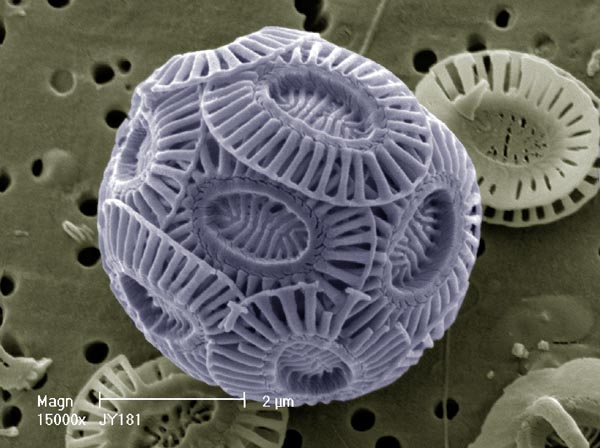
Emiliania huxleyi, a very common marine coccolithophore.
From Portal to Protistology.
- Diatoms are described in the chapter on Marine
Fisheries Food Webs.
- Ciliates They
are filter feeders with many hairlike cilia. Some are no larger
than a large bacteria, others can be seen by the naked eye. A paramecium
is a common example of a cilate.
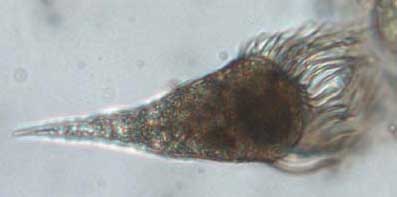
A marine ciliate of the genus strombidium.
From Gulf of Alaska Plankton Photos.
- Dinoflagellates are a large group
of organisms with two, hair-like flagella which they use to swim
through the water. About half of the species are photosynthetic.
Some species occur in dense blooms of more than 109 cells
per liter called harmful
algal blooms, producing potent neurotoxins that accumulate
in marine animals and that kill fish. People become ill or die
when they eat fish or shell fish that have accumulated the toxins.
Some species are the zooxanthellae that live in the cells of corals
and anemones. Others, such as Noctiluca,
produce light when disturbed. Dinoflagellates tend to dominate
in regions of low turbulence and nutrients, such as oceanic areas
in late summer. Sizes range from 30 micrometers for some marine
species up to 2,000 micrometers (2 mm) for Noctiluca.
Some Vocabulary
All organisms need energy, electrons, and carbon (plus associated nitrogen, phosphorus, and sulphur) to grow and thrive. Organisms can be classified by how they obtain energy and nutrients. Note -troph means to nourish. From Greek trophos = "nourishment."
- Autotrophs synthesize their own complex carbon
compounds.
- Phototrophs such as phytoplankton use energy from sunlight plus carbon dioxide and water to synthesize complex carbon compounds.
- Chemotrophs use energy from inorganic chemical compounds, such as methane, hydogen sulphide, or reduced iron plus carbon dioxide or some organic carbon to synthesize complex carbon compounds.
- Mixotrophs are organisms that can use energy from both sunlight and chemical compounds.
- Heterotrophs are organisms that must eat
other organisms to obtain complex carbon compounds. Some are able to
use sunlight or inorganic compounds for energy, others must use organic
carbon compounds for energy. People are heterotrophs that get complex
carbon compounds and energy from other organisms.
- Bacteriovores eat bacteria.
- Herbivores eat plants.
- Carnivores eat animals.
References
Barber, R. T. and A. K. Hilting (2000). Achievements in biological oceanography. In: 50 Years of Ocean Discovery. Ocean Studies Board. Washington DC, National Academy Press: 11–21.
Barber, R. T. (2007). OCEANS: Picoplankton Do Some Heavy Lifting. Science 315 (5813): 777–778.
Bohannon, J. (2007). METAGENOMICS: Ocean Study Yields a Tidal Wave of Microbial DNA. Science 315 (5818): 1486–1487.
Copley, J. (2002). All at sea. Nature 415: 572–574.
Ducklow, H. (2000). Bacterial production and biomass in the ocean. In: Microbial Ecology of the Oceans. D. L. Kirchman, John Wiley: 85–120.
Gelbart, W. M. and C. M. Knobler (2008). The Physics of Phages. Physics Today 61(1): 42–47.
Karner, M. B., E. F. DeLong, et al. (2001). Archaeal dominance in the mesopelagic zone of the Pacific Ocean. Nature 409 (6819): 507–510.
Konneke, M., A. E. Bernhard, et al. (2005). Isolation of an autotrophic ammonia-oxidizing marine archaeon. Nature 437 (7058): 543–546.
Pearson, A. (2008). Biogeochemistry: Who lives in the sea floor? Nature 454 (7207): 952–953.
Pomeroy, L. R., P. J. L. Williams, et al. (2007). The microbial loop. Oceanography 20 (2): 28–33.
Rohwer, F. and R. V. Thurber (2009). Viruses manipulate the marine environment. Nature 459 (7244): 207–212.
Sherr, E. and B. Sherr (2000). Marine microbes: An overview. In: Microbial Ecology of the Oceans. D. L. Kirchman. New York, Wiley-Liss: 13–46.
Shreeve, J. (2004). Craig Venter's epic voyage to redefine the origin of species. Wired 12 (08): 104–113, 146–151.
Suttle, C. A. (2005). Viruses in the sea. Nature 437(7057): 356–361.
Venter, J. C., K. Remington, et al. (2004). Environmental Genome Shotgun Sequencing of the Sargasso Sea. Science 304 (5667): 66–74.
Zimmer, C. (2006). Did DNA Come From Viruses? Science 312 (5775): 870–872.
Revised on: 29 May, 2017

-2.gif)